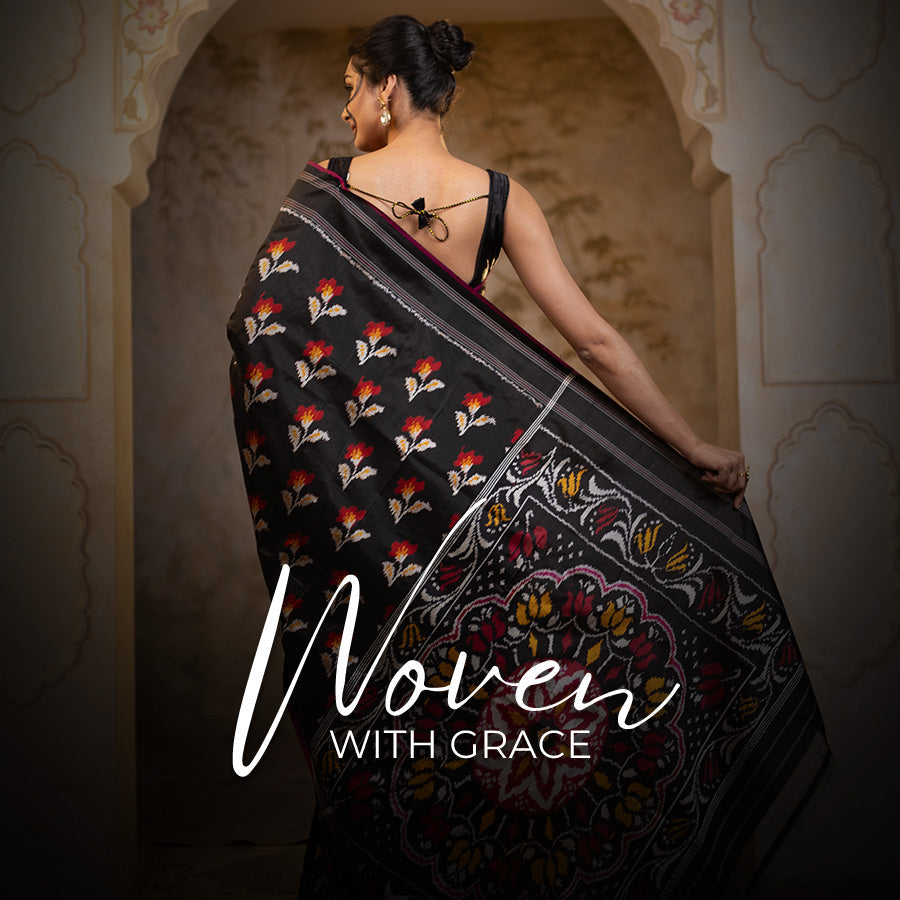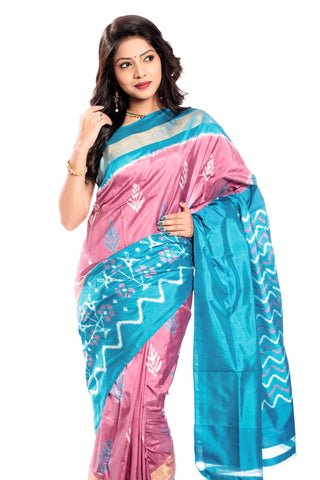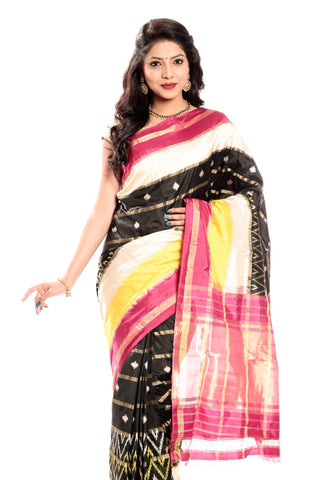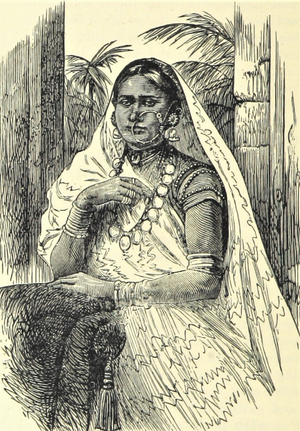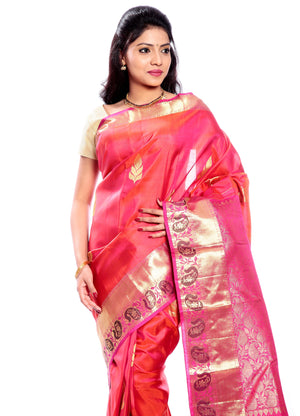Cart
0
Perceivably, you can spot Pochampally Ikkat sarees by their “chowkra” patterns which look like waves with diffused edges or diamonds inside a square and the likes of it.
Making of Pochampally Ikkat involves a tie-and-dye method where the yarns are dyed in elegant design patterns and then woven into the cloth. Widely, the cloth used is either cotton or silk.
Now, there’s more to the picture when it comes to Pochampally Sarees, so in this blog post we are going to look at the history, weaving techniques, motifs and latest trends in Pochampally ikkat sarees.
Without further ado, let’s get right into it:
Pochampally Sarees: History and Origin
The art of making Pochampally saree or Pochampally Ikat goes back to the 1950's in the town of Bhoodan Pochampally, Telangana.
At the time, the village head of Pochampally was determined to create weaves of cotton along with silk to boost labour profits. The traditional Pochampally Ikat weaving technique was brought to the town from Chirala, where they called the art as ‘Chit-ku’. Many weavers then learned and inherited the secrets of this art.
Soon the wave spread across different mandals of Pochampally and the town became popular and capable enough to compete with other silk manufacturers across India. The weaving technique was very well-received in the industry due to the unique and classic nature of the fabric produced.

By the year 1999, the Pochampally Ikat weaving techniques were spread across 10,000 families of artisans in 100 villages. Thus, this made the whole process of ikat making easier and cost-effective. Just after that, the machines were introduced in 2000 to make the weaving technique more precise and fast.
And, that’s how it all started back in the 20th century, leading to its evergreen influence on the tie and dye patola industry of India.
Evolution of Pochampally Ikat
Popularly referred to as ‘Silk City of India’, this town has given exceptional silk textile to the industry, posing tough competition to other Ikat weavings in India. With increasing demands, these Pochampally sarees soon flaunted silk Ikats wherein silk was brought from Bangalore and zari from Surat. Most sarees boast mesmeric geometric patterns on them handcrafted by expert artisans through the Ikat dyeing method.
These skilled artisans have decades of expertise in creating intricate designs and color combinations to create perfect masterpieces. Some Pochampally sarees can even take up to 100 days to make until it's crafted to precision.
Today, the Pochampally Ikat weaving is preeminently evolving across the entire Yadadri Bhuvanagiri district. The art of weaving Pochampally sarees is quite contemporary, and doesn't really have solid native roots like other Ikat productions may have.
In 2010, the Indian government distributed the belt into two respective clusters or main weaving centers viz. Pochampally 1 and Pochampally 2. By the same token, efforts are being made by the government as well as various handloom organizations to revive this dying weaving art.
Art of Ikat weaving
Pochampally Ikkat Silk Sarees provide phenomenal comfort with a hint of elegance and grandeur that’s customarily expected from silk fabric.
The weaves of Pochampally are primarily recognized as ‘Ikat’, ‘Ikkat’ and sometimes ‘tie and dye’ weaves.
Ikat literally means tie. This resist dyeing method refers to the technique of creating the resist by binding bundles or single yarns. Then a tight wrapping is applied on the yarns in a geometric pattern and then these yarns are dyed.

Artisans may alter the bindings to create attractive new patterns and dye them again to make breathtaking colour hues. This procedure is repeated multiple times until the desired patterns and multi-colours are produced. Once dyeing finishes, the bindings are finally removed and the yarns are free to be woven into the cloth now.
Types of Ikat
In Telangana State, the Pochampally Ikat is also popularly known as Buddabhashi, Chitki and Pogudubandhu. But, it is known as Pochampally all across the country.
Generally, Ikkats are of two types-
Warp ikat or Single Ikat is a tie and dye method where only the warp is resist-dyed and then woven with the weft. The weft may be dyed with a single color or have no color at all. In such a technique, the pattern is clearly visible on the warp even before it is woven with the weft. Warp yarn could be of silk, jute, cotton or any other suitable fiber.
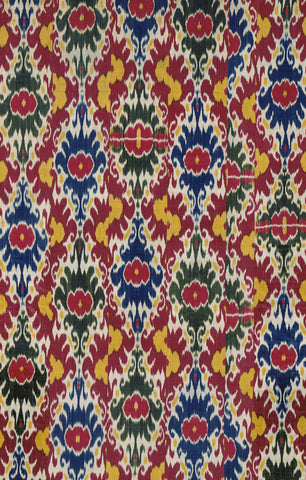
Weft ikat is a technique where you will see dye patterns on the weaving weft yarns. Hence, the ikat patterns will become visible as the weaving progresses. Such a technique is time-consuming as artisans need to precisely line up the weft yarns for perfect design outcomes. It is generally employed when overall results are much more important than the precision of patterns.

Double Ikat is the process where both- the warp and the weft go through resist dyeing procedure. After which, they are woven into a single cloth. As a matter of fact, this is the most difficult and expensive type of weaving process.
Pochampally Ikat makes use of the double Ikat method of transferring intricate patterns onto the cloth.
Key Differentiation between Ikat vs. Batik
In batik or other resist-dyeing methods, generally, the resist is applied directly onto the woven fabric.
But in Ikat, the resist dyeing is carried out on yarns, and then, later on, they are woven into the desired cloth. In Ikat sarees, the surface design is imposed on yarns and not on woven cloth, so both the faces of fabric feature patterns.
Another thing that makes Ikat stand out from the rest is the apparent blurriness of the geometric design. The blurriness signifies how extremely difficult it was for the weaver to line up dyed yarns to make sure the finished cloth has perfect Ikat patterns.
Ikkat sarees with complicated patterns, multiple color hues and slight blurriness are quite difficult and time-consuming to make. Thus, these sarees are much more expensive than the ones with simple patterns.
Other types of Ikats
Pochampally or Double Ikats are widely produced in the villages of Bhoodan Pochampally and Puttapaka in the state of Telangana.
You must know that Pochampally, Patola and Ikat- all of these refer to the same double ikkat weaving technique. The main difference between a Patola and Pochampally saree is their design language and geographical location. This refers to the fact that Patolas are made in Patan, Gujarat, while Pochampallys belong to Telangana.
But apart from these, there are a plethora of Ikat techniques flourishing in other parts of India.
Some of the popular ikat weaving techniques are as follows:
- The indigenous Sambalpuri Ikat practised in Orissa is quite intricate.
- Whereas the Patan Patola- a rare technique of Double Ikat is made in Patan of Gujarat. Patan Patola boasts sharp Ikat patterns and demands great effort in dyeing and weaving. It is made with the use of premium silk yarns and generally features myriads of colors. Some Patan patola sarees might have no repeats, whereas others have repeated motifs throughout the saree.
- Another double ikat weaving is also carried out in Puttapaka of Nalgonda District and it is known as Puttapaka Saree.
- Orissa’s Pasapalli ikat saree has some kind of chequered design on it and uses the same method as the Sambalpuri ikat. ‘Pasapalli’ word derives itself from the word ‘Pasa’ which means a chequered board game (like Ludo).

Fabrics Used
In all types of Ikat, the color on the cloth is obtained from natural resources. And, the fabrics used to produce these Pochampally sarees are mostly cotton, silk, and SICO (a blend of cotton and silk).
The smooth texture, neatness and lightweight nature of the fabric are factors that differentiate Pochampally Ikat sarees from other types of Ikats.
Pochampally and Patola saree both share similar tie-and-dye technique, but they also share an interesting tale of migration. The Salvis migrated from South India to Patan to weave silk Patola Sarees for the King. On the other hand, two brothers belonging to the traditional weaving community, named Venkiah and Malliah migrated from Chirala to Pochampally.
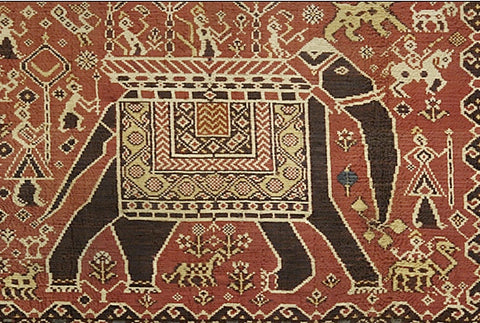
Pochampally Pattu Sarees or Ikkat Pattu Sarees are all about silk, as the name “pattu” itself is a traditional name of silk in Telugu and Tamil languages of South India.
Initially, Pochampally or Ikkat Sarees were only woven in coarse cotton fabrics, but later silk became a popular choice of fabric after all. In fact, the Bhoodan Pochampally town had the title of being a ‘silk mine’ of India up its sleeve back in the 18th century.
Pochampally silk sarees are lightweight and extremely comfortable to wear, making them perfect for summers! The classic and rich look of silk makes it an ideal choice for weddings and festivals.
Motifs and Colors
Traditionally, the famous Pochampally silks and sarees only had geometric patterns on them. But in today’s date, you will see various modern intricate motifs making their way into these weavings such as beautiful flowers, leaves, circles, paisleys and more. These intricate details give a mesmerizing touch to the Pochampally sarees, as the Ikats are smooth and sharp.
Some Pochampally sarees even flaunt bold geometric lines or bootie designs.
Latest Trends and Designs
Many trends may come and go, but Pochampally Ikat continues to keep its foot firmly in the industry.
Latest trends in Pochampally sarees are all about multicolor patterns and modern motifs such as elephants, parrots, peacocks, etc. The colors used are generally bright with gold, yellow, orange, blue and pink dominating the weaves.
Mandakini Store: Buy Pochampally Silk Sarees Online
Here at Mandakini, you will find most quintessential Pochampally Ikkat Silk Sarees in Yellow-Blue, classic Black-Red combination, elegant Ivory Pochampally with a hint of red or purple and Rani pink Pochampallys with beautiful dull gold border.
Our collection has the most traditional forms of Pochampally Ikkat patterns, but you will also see a plethora of modern Pochampally silk sarees inspired by the Patola sarees of Patan, Gujarat. These sarees have modern motifs on them boasting a mix of dancing girls, flowers, leaves, elephants, parrots and deers infused within geometrical grids.
We have even got exquisite Pochampally sarees with temple designs and checkered, stripes and triangles patterns!
Many of our pieces still flaunt traditional rumal-style layout with wide borders. Plus, you’ll also notice use of zari weaves in some saree pallus that add a hint of richness to it.
Mandakini uses a wide range of color hues in Pochampally Ikkat Silk Sarees, right from breathtaking ananda color to graceful maroon, ivory, light green, grey and even turmeric yellow hues.
Authentic Pochampally Ikkats
Pochampally Ikat is a registered textile, which belongs to local businesses, Pochampally Handloom Weavers Cooperative Society and the Pochampally Handloom Tie and Dye Silk Sarees Manufacturers Associations.
The fabric was honored with a coveted GI (Geographical Indication) tag in the year 2005 and that’s exactly how it is marketed to the common public through these organizations. GI Tag differentiates Pochampally Sarees from other Ikat products in the market and also promotes exports, builds national identity and prevents duplicate productions.
Pochampally Ikat has also marked its place as “iconic saree weaving clusters of India” in UNESCO’s tentative list of world heritage.
Even the flight attendants of the Air India airplanes (official Indian Government airlines) are seen flaunting mesmeric Pochampally Silk sarees as their on-duty uniform.
Wrap Up
With this we wrap up our comprehensive blogpost on Pochampally Sarees. Hope you’ve got some invaluable insights on the historical significance, Ikat weaving techniques and influence of Pochampally Ikats on the market.
These Pochampally Ikkat Silk Sarees or Ikkat Pattu Sarees easily pass as classic ethnic wear, as they boast exotic blend of fabric and exquisite motifs. No doubt, they are the glory of the Telangana State!

